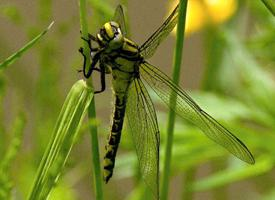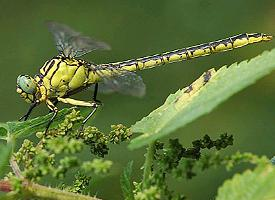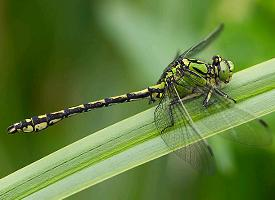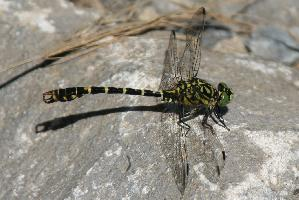
Greutăți și măsuri
| Lungime | de la 45 la 50 mm |
|---|---|
| Lungimea anvergurii aripilor | de la 60 la 70 mm |
Descrierea animalului
The Common Clubtail (Gomphus vulgatissimus) is a captivating species of dragonfly that graces many waterways across Europe. With a lifecycle and behavior as intriguing as its appearance, this species is a fascinating subject for both casual observers and entomologists alike.Morphologically, the Common Clubtail is a medium to large dragonfly, with adult lengths typically ranging from 5 to 6 centimeters. One of its most distinguishing features is the club-shaped abdomen, particularly pronounced in males, from which it derives its common name. This bulbous enlargement at the tail end is not just for show; it contains the muscles necessary for its agile flight. The body coloration is a striking combination of yellow and black. The thorax and abdomen are predominantly black with unique yellow markings that can serve as an identification mark. Their wings are transparent with a slight yellow tint near the body, which becomes more pronounced with age. The eyes are large and green, providing them with excellent vision for hunting and navigating through their habitat.
Habitat-wise, Gomphus vulgatissimus prefers slow-moving rivers and streams, often with a muddy or sandy bottom. These environments provide the necessary conditions for the nymph stage of the dragonfly, which is aquatic. The nymphs are predators, feeding on a variety of aquatic organisms until they undergo metamorphosis into their adult form. This transformation is one of nature's remarkable spectacles, as the nymph climbs out of the water onto a plant or rock, sheds its exoskeleton, and emerges as a fully formed adult dragonfly.
The diet of the Common Clubtail, both in its nymph and adult stages, is carnivorous. Nymphs will prey on aquatic invertebrates and even small fish, while adults are adept hunters of flying insects. Their hunting technique is both efficient and deadly; they catch their prey in mid-air with their legs, which are covered with spines to trap the unfortunate insect.
Reproduction is another fascinating aspect of the Common Clubtail's lifecycle. Mating typically occurs in flight, after which the female lays her eggs in the water, often on vegetation or directly into the sediment. The eggs hatch into nymphs, and the cycle begins anew. This reproductive strategy ensures the continuation of the species in its aquatic nursery.
The Common Clubtail, while not currently listed as endangered, faces threats from habitat destruction and pollution. The degradation of river ecosystems through industrial and agricultural activities poses a significant risk to their populations. Conservation efforts are essential to preserve the habitats of these remarkable insects and ensure that they continue to thrive in their natural environments.
In summary, the Common Clubtail is a fascinating dragonfly with a complex lifecycle and intriguing behaviors. Its presence in European waterways adds to the biodiversity of these ecosystems, and its study can provide insights into the health of aquatic environments. Whether seen darting along a riverbank or observed during its dramatic metamorphosis, the Common Clubtail never fails to captivate those who encounter it.
Animale similare
Fotografii noi cu animale
Top 10 animale
- Dolphin gull (Leucophaeus scoresbii)
- Diana monkey (Cercopithecus diana)
- Moustached guenon (Cercopithecus cephus)
- Galápagos tortoise (Geochelone nigra complex)
- Stone loach (Barbatula barbatula)
- Japanese macaque (Macaca fuscata)
- Greek tortoise (Testudo graeca)
- Russian tortoise (Testudo horsfieldii)
- Common flying dragon (Draco volans)
- Galápagos penguin (Spheniscus mendiculus)


